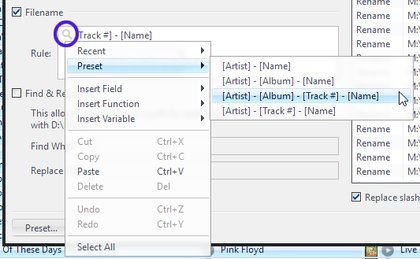Filename Template: Difference between revisions
Jump to navigation
Jump to search
No edit summary |
No edit summary |
||
| Line 13: | Line 13: | ||
* The rule may also contain [[Expression Language]] functions. |
* The rule may also contain [[Expression Language]] functions. |
||
* All text entered that does not match a valid Library Field or Expression Language function will be passed through verbatim. |
* All text entered that does not match a valid Library Field or Expression Language function will be passed through verbatim. |
||
* The disclosure button in the Rule text box shows a pop-out menu that shows recently-used templates, a few presets, allows you to insert Expression Language functions, and other handy tools. |
|||
[[File:RMCF-Filename-Disclosure Button-Win.png|thumb|420px|none|The disclosure button in the Filename Template box on Windows.]] |
|||
[[Category:Rename, Move, and Copy Files]] |
[[Category:Rename, Move, and Copy Files]] |
||
Revision as of 17:31, 24 May 2015
- See also: Rename, Move, and Copy Files
The Filename Template is used to set the naming of the files selected in the tool. Like the Directories Template, it consists of a Rule which auto-generates the filename base on each file's metadata. The Filename Template does not consider the source filenames at all, and the replacement name is built from scratch using the Rule.
For example, you might want to name your music files with their [Disc #], [Track #], and [Name], and your movies with their [Name] and [Year].
Use
The Filename Template consists of only a single Rule, which is constructed using the following system:
- If the Filename Template is not enabled, the files' existing filenames will be passed through untouched.
- Insert file-specific properties by using the standard Library Field square bracket notation, such as [Track #], [Episode], [Year], or [Name].
- The rule may also contain Expression Language functions.
- All text entered that does not match a valid Library Field or Expression Language function will be passed through verbatim.
- The disclosure button in the Rule text box shows a pop-out menu that shows recently-used templates, a few presets, allows you to insert Expression Language functions, and other handy tools.

